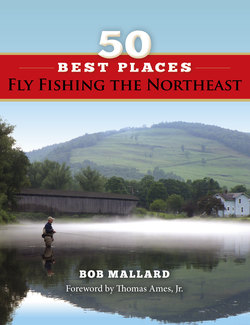Читать книгу 50 Best Places Fly Fishing the Northeast - Bob Mallard - Страница 15
На сайте Литреса книга снята с продажи.
ОглавлениеThe Northeast
COMPRISED OF THE SIX New England states, plus New York, New Jersey, and Pennsylvania, the Northeast represents a relatively small part of the country from a geographic standpoint. No state ranks higher than 30th in the nation in regard to size. Six are among the 10 smallest—including the smallest, Rhode Island. Eight of the 9 are within the 20 smallest.
Conversely, four of the states are within the top 10 in the nation in regard to population. Six of the 10 most densely populated states are in the Northeast—including the top four, New Jersey, Rhode Island, Massachusetts, and Connecticut. Population densities range from a low of about 40 people per square mile in Maine to over 1,000 people per square mile in New Jersey. The Northeast is home to roughly 20 percent of the nation’s population—and within a short drive of about another 10 percent.
The History
While the focus in regard to fly fishing has shifted west over the years, it is important to remember that the Northeast is where it all started. From the historic hotels and sporting camps of Maine, to the hallowed waters of the Catskills, to the fabled limestone creeks of Pennsylvania, the Northeast has a rich fly-fishing history.
The Northeast was a hotbed for early fly design. From Carrie Stevens and her fabled Grey Ghost streamer, to Bill Bennett and his groundbreaking Pontoon Hopper, to Theodore Gordon and his delicate Quill Gordon dry fly, much early fly innovation came from the Northeast. In recent years, tiers such as Fran Betters, Dick Talleur, Dick Stewart, David Klausmeyer, Don Bastian, Ed Muzzerol, and David Mac have been torch bearers for classic fly tying.
Many early fly-fishing tackle manufacturers came from the Northeast as well. From Orvis—founded on the banks of the Batten Kill in Vermont—to Thomas and Thomas in Massachusetts, to Cortland Line Company in New York, to outdoor giant L. L. Bean in Maine, to the numerous early bamboo rod shops scattered across the region, the Northeast accounted for much of the fly-fishing tackle available in the 19th and early 20th centuries.
The Northeast was also well represented on the literary front. From Arthur R. MacDougall, Jr., famous for creating the fictional character Dud Dean, to the classic writings of Alfred W. Miller—aka Sparse Grey Hackle—to the technical genius of Vince Marinaro, Charlie Fox, and Ed Koch, to the insightful writings of Ernie Schwiebert, to the conservation prose of Ted Williams, to entomology guru Thomas Ames, Jr., the Northeast has produced some of the most important and groundbreaking fly-fishing writing in history.
Then there is the celebrity. From the time when the first Atlantic salmon caught in Maine each season went to the president of the United States, to the local ramblings of baseball legend Ted Williams and his friend, sportscaster Curt Gowdy, to TV personality Gadabout Gaddis and his 1970s show, The Flying Fisherman (filmed on the banks of the Kennebec River in Maine), the Northeast has been highly visible in the world of fly fishing.
Finally are the ambassadors of the sport. From Cornelia “Fly Rod” Crosby (1854–1946)—Maine’s first registered guide, to Leon Chandler of Cortland Line fame, to Leon Leonwood Bean of L.L. Bean fame, to George Harvey’s Pennsylvania college teachings, to Cathy and Barry Beck’s endless promotion of tackle and techniques, to Tom Ackerman and his resurrection of the classic American Sportsman show, the Northeast has always been at the forefront of fly-fishing promotion.
The Waters
The rivers, streams, brooks, and creeks of the Northeast can be divided into three primary categories—tailwater, freestone, and limestone. What constitutes a river, stream, brook, or creek is less clear. Some rivers are smaller than some streams. There is no identifiable characteristic that differentiates a stream from a brook. Most—but not all—creeks are either limestone or coastal.
A tailwater is a section of river downstream of a dam. Many expect tailwaters to be cold, clear, and rich in nutrients, with specific types of plant and insect life. Very few rivers in the Northeast fit this description. While some tailwaters in the Northeast have consistent and cold flows,
